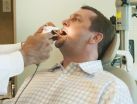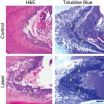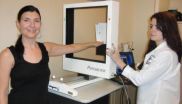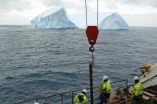(Press-News.org) DALLAS – May 28, 2014 – UT Southwestern Medical Center cancer researchers have identified a protein critical to the spread of deadly cancer cells and determined how it works, paving the way for potential use in diagnosis and eventually possible therapeutic drugs to halt or slow the spread of cancer.
The protein, Aiolos, is produced by normal blood cells but commits a kind of "identity theft" of blood cells when expressed by cancer cells, allowing the latter to metastasize, or spread, to other parts of the body. Metastatic cancer cells have the ability to break free from tissue, circulate in the blood stream, and form tumors all over the body, in a way acting like blood cells.
"This is an important discovery because the metastatic spread of tumors accounts for the vast majority of cancer-related deaths. Now that we know the role of Aiolos, we can look toward therapeutic intervention," said Dr. Lance Terada, Professor of Internal Medicine and Chief of the Division of Pulmonary/Critical Medicine at UT Southwestern.
The research, available online and in the journal Cancer Cell, found that Aiolos, which frequently is expressed in lung cancers, is a predictor of a markedly worse prognosis in lung cancer patients.
Aiolos is a member of a class of proteins called transcription factors — proteins that control which genes are turned on or off by binding to DNA and other proteins. Once bound to DNA, these proteins can promote or block the enzyme that controls the reading, or "transcription," of genes, making genes more or less active.
Aiolos decreases the production of cell adhesion proteins and disrupts critical cell adhesion processes, including processes that allow tissue cells to anchor to their physical environment, a necessary requirement for cells to survive and spread. Metastatic cells don't need this adhesion, allowing them to proliferate instead. Aiolos also represses another protein called p66Shc, which otherwise would suppress metastatic ability, which is the ability of the cancer cells to spread.
"Despite their importance, cellular behaviors that are largely responsible for cancer mortality are poorly understood," Dr. Terada said. "Our study reveals a central mechanism by which cancer cells acquire blood cell characteristics to gain metastatic ability and furthers our understanding in this area."
INFORMATION:
The research was done in collaboration with a team from the Tianjin Medical University, China, led by Dr. Zhe Liu, a former postdoctoral research fellow of Dr. Terada and co-corresponding author on the paper. Other UT Southwestern researchers involved include Dr. John Minna, Professor of the Nancy B. and Jake L. Hamon Center for Therapeutic Oncology Research, Internal Medicine, and Pharmacology, and Dr. Luc Girard, Assistant Professor of Pharmacology.
Dr. Minna and Dr. Girard are members of UT Southwestern's Harold C. Simmons Cancer Center, the only National Cancer Institute-designated cancer center in North Texas and one of just 66 NCI-designated cancer centers in the nation. The Harold C. Simmons Comprehensive Cancer Center includes 13 major cancer care programs with a focus on treating the whole patient with innovative treatments, while fostering groundbreaking basic research that has the potential to improve patient care and prevention of cancer worldwide. In addition, the Center's education and training programs support and develop the next generation of cancer researchers and clinicians.
The work was supported by the Ministry of Science and technology of China, the National Natural Science Foundation of China, the Tianjin Municipal Science and Technology Commission, the specialized Fund for Doctoral Program of Higher Education, the China Postdoctoral Science Foundation, the James M. Collins for Biomedical Research, and the National Institutes of Health.
About UT Southwestern Medical Center
UT Southwestern, one of the premier academic medical centers in the nation, integrates pioneering biomedical research with exceptional clinical care and education. The institution's faculty includes many distinguished members, including six who have been awarded Nobel Prizes since 1985. Numbering more than 2,700, the faculty is responsible for groundbreaking medical advances and is committed to translating science-driven research quickly to new clinical treatments. UT Southwestern physicians provide medical care in 40 specialties to nearly 91,000 hospitalized patients and oversee more than 2 million outpatient visits a year.
This news release is available on our home page at
http://www.utsouthwestern.edu/home/news/index.html
To automatically receive news releases from UT Southwestern via email,
subscribe at http://www.utsouthwestern.edu/receivenews
International collaboration highlights new mechanism explaining how cancer cells spread
2014-05-28
ELSE PRESS RELEASES FROM THIS DATE:
Suspect strep throat? Re-check negative rapid test results with lab culture
2014-05-28
Clinical guidelines conflict on testing teens and adults whose symptoms point to a possible strep throat. A chief contention is whether negative tests results from a rapid analysis of a throat swab, done in a doctor's office, should be confirmed through a follow-up laboratory culture.
The rapid test detects certain antigens, one of the body's efforts to fight off strep bacteria. Attempting to grow bacteria from a throat specimen double checks for the presence or absence of Group A Streptococcus bacteria, as well as a few other bacterial infections.
A study published ...
Negative social interactions increase hypertension risk in older adults
2014-05-28
PITTSBURGH—Keeping your friends close and your enemies closer may not be the best advice if you are 50 or older.
New research from Carnegie Mellon University's Rodlescia Sneed and Sheldon Cohen shows that unpleasant or demanding interpersonal encounters increase hypertension risk among older adults.
Published in the American Psychological Association's journal Health Psychology, the study provides some of the first concrete evidence that negative social interactions not only influence psychological well-being but also physical health – in this case, blood pressure ...
T cell repertoire changes predictive of anti-CTLA-4 cancer immunotherapy outcome revealed
2014-05-28
Sequenta, Inc. today announced publication of a study done in collaboration with researchers from UCSF and UCLA that used the company's proprietary LymphoSIGHT™ immune repertoire sequencing platform to investigate the effects of anti-CTLA-4 antibody on the number and types of T cells present in a patient's blood. The results, which appear in the May 28 issue of Science Translational Medicine, shed light on the mechanism of action of this type of cancer immunotherapy and suggest that immune repertoire sequencing could be used to predict which patients will have improved ...
Study: Amphetamines can delay exhaustion during exercise in the heat -- at a cost
2014-05-28
Indiana University researchers put male rats to the test to determine the role amphetamines play when used in conjunction with exercise.
When people or animals exercise in the heat, exhaustion is a safety gauge telling the body it is time to stop. Exhaustion occurs when the body's core temperature reaches a potentially dangerous point. The use of amphetamines is banned in many sports because they increase time to exhaustion.
What they found: Amphetamines can delay exhaustion during exercise in the heat by increasing the temperature at which it occurs. This potentially ...
Researchers use light to coax stem cells to repair teeth
2014-05-28
A Harvard-led team is the first to demonstrate the ability to use low-power light to trigger stem cells inside the body to regenerate tissue, an advance they reported in Science Translational Medicine. The research, led by Wyss Institute Core Faculty member David Mooney, Ph.D., lays the foundation for a host of clinical applications in restorative dentistry and regenerative medicine more broadly, such as wound healing, bone regeneration, and more.
The team used a low-power laser to trigger human dental stem cells to form dentin, the hard tissue that is similar to bone ...
EARTH magazine: The history, science and poetry of New England's stone walls
2014-05-28
Alexandria, Va. — When author John-Manuel Andriote returned to his hometown in New England after years away, he noticed something that had been invisible to him while growing up there — the old stone walls tumbling off into the forests. The realization that the crumbling and overgrown walls meant those forests had once been cleared farm lands set Andriote on a years-long journey of discovery that highlights the intersections of geologic and human history.
The story of New England's stone walls begins with the glaciers of the last ice age, meanders through the Colonial ...
Some high blood pressure drugs may be associated with increased risk of vision-threatening disease
2014-05-28
SAN FRANCISCO – May 28, 2014 – There may be a connection between taking vasodilators and developing early-stage age-related macular degeneration (AMD), the leading cause of vision loss and blindness among Americans who are age 65 and older, according to a study published online in Ophthalmology, the journal of the American Academy of Ophthalmology.
AMD – the deterioration of the eye's macula, which is responsible for the ability to see fine details clearly – affects an estimated 11 million people in the United States. In addition to increased age, the cause of AMD ...
NYU researchers pilot educational and behavioral program to reduce lymphedema risk
2014-05-28
Viewed as one of the most unfortunate outcomes of breast cancer treatment, lymphedema is characterized by an accumulation of lymph fluid in the interstitial spaces of the affected limb, leading to chronic ipsilateral limb swelling causing psychosocial distress and physical challenges for patients.
Even conservative estimates suggest that 3% of women who have had sentinel lymph node biopsy and 20% of those who have had axillary lymph node dissection may develop lymphedema a year after breast cancer surgery. Two established risk factors for lymphedema are compromised ...
A cure for dry eye could be a blink away
2014-05-28
A treatment for dry eye—a burning, gritty condition that can impair vision and damage the cornea—could some day result from computer simulations that map the way tears move across the surface of the eye.
Kara Maki, assistant professor in Rochester Institute of Technology's School of Mathematical Sciences, contributed to a recent National Science Foundation study seeking to understand the basic motion of tear film traversing the eye. "Tear Film Dynamic with Evaporation, Wetting and Time Dependent Flux boundary Condition on an Eye-shaped Domain," published in the journal ...
Antarctic ice-sheet less stable than previously assumed
2014-05-28
The first evidence for massive and abrupt iceberg calving in Antarctica, dating back 19,000 to 9,000 years ago, has now been documented by an international team of geologists and climate scientists. Their findings are based on analysis of new, long deep sea sediment cores extracted from the region between the Falkland Islands and the Antarctic Peninsula. The study in the May 28, 2014 issue of Nature bears witness to an unstable Antarctic ice sheet that can abruptly reorganize Southern Hemisphere climate and cause rapid global sea level rise.
"One of the iceberg events ...




